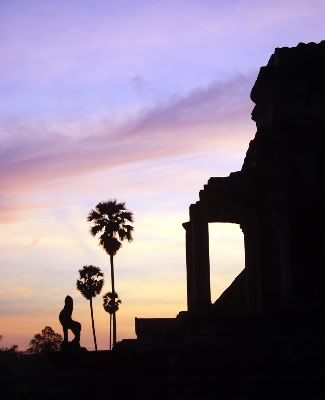
At 5am this morning Panha drove us north to the temple of Angkor Wat – perhaps the most famous of Cambodia's temples – where rumour had it the sun was due to rise. Although the rest of the temples in the area face east, symbolising new life by catching the rising sun, Angkor Wat was built as a mausoleum for some god-king and so faces west, making it the only temple in Cambodia where you can watch the sun rise behind it. It also claims to be the largest religious structure on the planet, although they cheat by including the perimeter walls which run around a mile or so away from the temple itself.
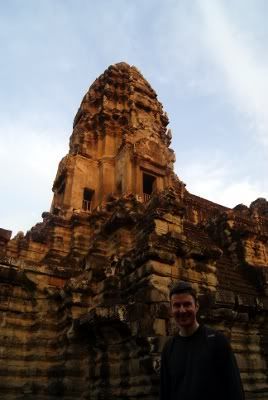
It turned out we weren't the only ones to read about the sunrise in the guide book, with three or four hundred other people clumped around a small lily pond two hundred feet in front of the temple, trying to get the same photo of the sun rising behind temple, reflected in the pond. Figuring we could probably see plenty of pictures of that through Google, we went a bit closer and so were the only ones standing in its shadow as it rose, which was a lot more atmospheric.

We were also the first ones into the temple once the sun was up, and for a brief moment I was able to race around the deserted corridors in search of chambers, sunken pools, grassy clearings and eroded towers. Alas, as the tourists started filing in and the security attendants took their places to enforce a one-way route around the temple it turned out to be a rather symmetrical and dull place. While it's easy to get carried away and see the temple as a mysterious accomplishment of the ancients, it's informative to note that it was built at pretty much the same time as Notre Dame in Paris, which I would consider a more beautiful and enduring building.
We wandered back to the taxi – taking the obligatory lily pond shot as we passed – and had some special eggs and pancakes for breakfast before pressing on to our next sight: Angkor Thom.

When we visited Angkor Thom I didn't know anything about its history, but we've since learned that it was once the capital city of the Khmer empire – apparently once the greatest power in South East Asia – but was abandoned in the sixteenth century when the king moved his seat south. Although most of the city has now been lost to the jungle, everything built from stone remains, including the city gates, a number of temples and a series of raised terraces. We entered the city over a bridge flanked with dozens of ancient statues to reach the South Gate, on top of which are carved gigantic heads facing in the four directions of the compass.

We then drove through to the main temple of Bayon, which from a distance appeared to be no more than piles of stones but, as we got closer, turned out to have yet more huge heads carved into each tower. Bayon was great fun to clamber around, although in my excitement I did stumble across a dark recess high up in the central tower which the security guards clearly used as a urinal.
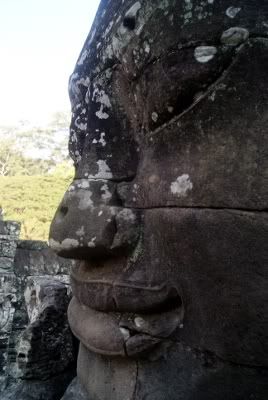
Less exciting was Bayon's neighbour, the temple of Baphuon, which you can only view from a single raised platform. Built on tiers of sand, Baphuon finally collapsed fifty years ago and is now undergoing reconstruction. As restoration goes, it looked like a bit of a dog's dinner. The central tower – which in a Victorian etching looks sleek and elegant – is built from random stones piled up higgledy-piggledy, some bearing carvings that don't even match up with their neighbours. We later learned that the ruins of the temple were entirely dismantled and catalogued by Cambodian archaeologists in the early 1970s, and then Pol Pot waded in and had them all executed and their records destroyed. The result is a giant 3D jigsaw, and it would appear the Cambodian's solution has been to take whichever stones they came across first – scooping them up from the ground with tractors– without applying any archaeological insight at all.
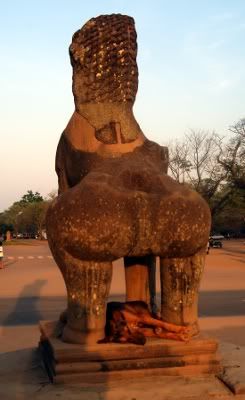
We were by this point suffering from the heat. Even before the sun had risen the air was hot and muggy, and by 9am the temperature was approaching 36 degrees (as attested by the dog pictured above, resting in the shade of its stone brother). We popped around the corner to take a look at the temple of Phimeanakas which – along with Baphuon – predates the founding of Angkor Thom and was incorporated into the new city. While Phimeanakas might have been exciting to see at the start of our visit – you know, when ancient temples in the jungle were still new to us – we were hot and tired and, apart from an odd looking sheep statue, it was really nothing special. We dutifully clambered up, stopped to catch our breath in the shade and then clambered down again without pausing to take in the view.

We walked down to the Terrace of the Elephants – a raised walkway with lots of elephants carved on the side, some faded or rudimentary and others detailed and pretty amazing – and then straight past the Terrace of the Leper King into Panha's air conditioned car. It was by this point only 10:30am and, since we'd hired Panha for the day, we figured we should see one more thing. As I couldn't bear the idea of going straight back out into the heat we decided to check out the temple of Banteay Srey, which is 15km north of Angkor Thom and so required a long and comfortable ride in the air conditioned cab. Banteay Srey is a small but elegant temple dating back over a thousand years and carved from a particularly cheerful shade of red sandstone. They have lots of monkey statues there, which I suppose is because it's dedicated to Rama, but really it was too hot to take much notice.
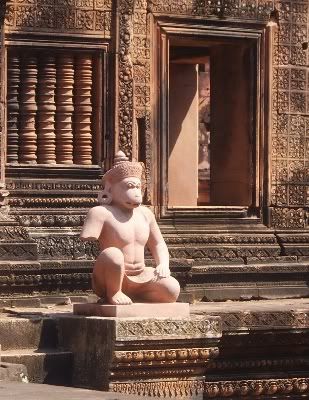
Only just midday, we returned to our hotel for a well-earned nap which saw us through to dinnertime. We ate summer rolls, green mango salad, Khmer soup and a chicken thing at the Cambodia Soup Restaurant on Pub Street, with explosive consequences for our bowels.




Regarding the temples facing East, couldn't you just nip round the back at sunrise, or did they contrive the backs to be devoid of silhouette?
ReplyDeleteHola spim. The backs are usually dense with rubble, jungle and/or landmines (since Princess Diana died 13 years ago I guess no-one's been waving the whip at the Halo Trust).
ReplyDeleteHowever, an obvious solution would be to go at sunset - a much more acceptable 6:30pm - and get largely the same photo.